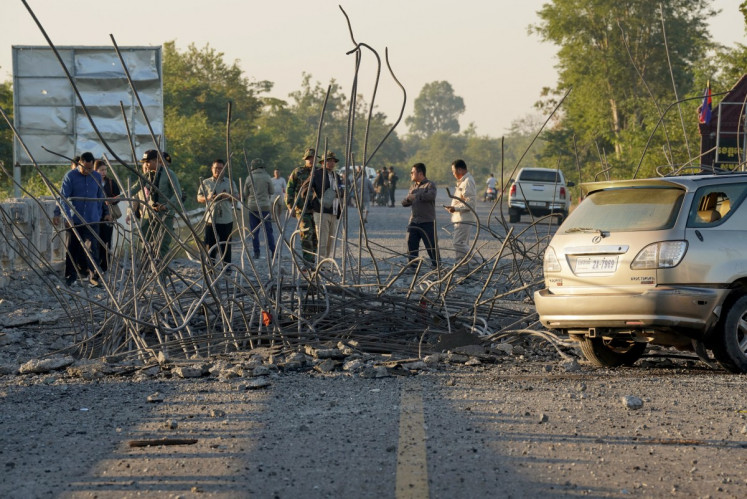Popular Reads
Top Results
Can't find what you're looking for?
View all search resultsPopular Reads
Top Results
Can't find what you're looking for?
View all search resultsEnergy and economic growth
The rapid economic growth of the currently developed nations during the last half of the 20th century was attributed notably to the availability of cheap energy, contributed mainly by fossil fuels, especially petroleum
Change text size
Gift Premium Articles
to Anyone
T
he rapid economic growth of the currently developed nations during the last half of the 20th century was attributed notably to the availability of cheap energy, contributed mainly by fossil fuels, especially petroleum. The challenge for developing countries nowadays is that the luxury of having plenty of cheap oil is no longer the case.
Energy economic literature defines two important indicators: Energy intensity as the ratio between energy consumption to GDP, and energy elasticity as the rate of growth of energy consumption over the rate of growth of GDP.
In Indonesia, energy plays an important role not only as fuel to grow the economy, but also as principal contributors to the country’s export earnings, GDP and to government revenues. The significant contribution of energy to Indonesia’s economy was clearly notable during the oil boom period (late 1970s — early 1980s) where at the same time our manufacturing was still small.
Data shows that for the last decade, the share of energy sector (oil, gas, and mining) to Indonesia’s GDP is continuously declining, from about 15 percent (2000) to currently about 10 percent, due particularly to faster growth of manufacturing and services.
An opposite trend exists between exports of energy commodities and their imports. The share of oil and gas to Indonesia’s total exports is declining slightly, from 23 percent (2000) to about 19 percent now.
Contrarily, imports of crude oil and petroleum products show a large increase, from 17 percent (2000) to currently about one third of Indonesia’s total imports.
The fact that our imports of oil (crude and products) is growing at a fast rate should make us worry, moreover the commodities are still sold largely in the domestic market below their import prices.
For the central government, even though there is notable progress on contribution from taxes, revenue donated by the energy sector is still essential, contributed to about — in the last 5 years — one third of the total government revenue, whereas there were years when oil and gas contribution increased noticeably.
The large and increasing contribution, however, was not due to increase in oil and gas production, but attributed to the high increase in oil prices. There was notable increase in mining contribution, due to an increase in coal production and prices.
In line with reforms and rapid changes in domestic and global political-economic scenes, the relation between energy and economy in Indonesia is challenged increasingly.
As elsewhere in the world, the cheap energy is no longer available. Today’s real price for oil for instance, is about 15 times what it was 3-4 decades ago. The economies of the Asian populous (China, India, Indonesia) and other developing countries are growing fast; their huge size of both population and large GDP asks for much larger amount of energy.
Today, energy is scarcer and has become a precious resource. Our economic growth can be sustained only if energy to fuel the growth is secured. Refer to the International Energy Agency Key World Energy Statistics, energy consumption per capita of Indonesia is about one fifth that of Japan.
Attempts to increase our energy consumption level, for instance to about half of the existing Japanese to be achieved by 2030 and equivalent to nowadays, Japanese by 2050 would require the provision of an additional amount of energy by roughly 100 percent (2030) and 4 times (2050) from the existing consumption. The fast economic growth scenario implies we have to have much more energy than these illustrations suggest.
As demand for energy grows, the task of providing them will not be easy since our energies are also demanded by our neighbor Asians and other countries sharing the increase in demand. Meanwhile, exploration and exploitation is getting tougher, our energy reserves — oil and gas in particular — are declining, and efforts to secure them from foreign sources are costly.
Energy cannot be consumed before adequate infrastructure to produce, process, transport and use them are in place. Our present energy demand, represented by consumption figures, is actually a “suppressed demand” or consumption restricted due to the availability of the existing infrastructure. As infrastructure becomes available (electricity and gas delivery for example), energy consumption will go up considerably.
Our energy elasticity is still more than one (2 — 3 for electricity in some regions) meaning demand for energy (and its infrastructure) runs faster than our economic growth rate. Multi billion US dollar investments are needed to make up for our lacking energy infrastructure. Energy intensity indicators suggest we consume energy inefficiently. Compared to Japan (one over eight), even to Malaysia, the Philippines and Thailand, we burn more energy to produce the same output.
Actually there is a large chance to implement energy conservation efforts for many energy consumers throughout Indonesia we should have taken. Large increase in demand, higher prices, tougher competition for energy supply even from our own reserves, lack of infrastructure and inefficient use are among the energy factors challenging our economic growth.
The national/regional strategic plans pointing to a certain economic growth needs to recalculate the amount of energy required to support the growth. Without doing these steps cautiously (including calculating the requirement for new infrastructure, investment, etc.) and taking the challenges for their realization, the political promise for achieving such an economic growth would probably miss the target.
The writer is the senior energy planner and an economist with the National Development Planning Agency. The opinions expressed are his own.










